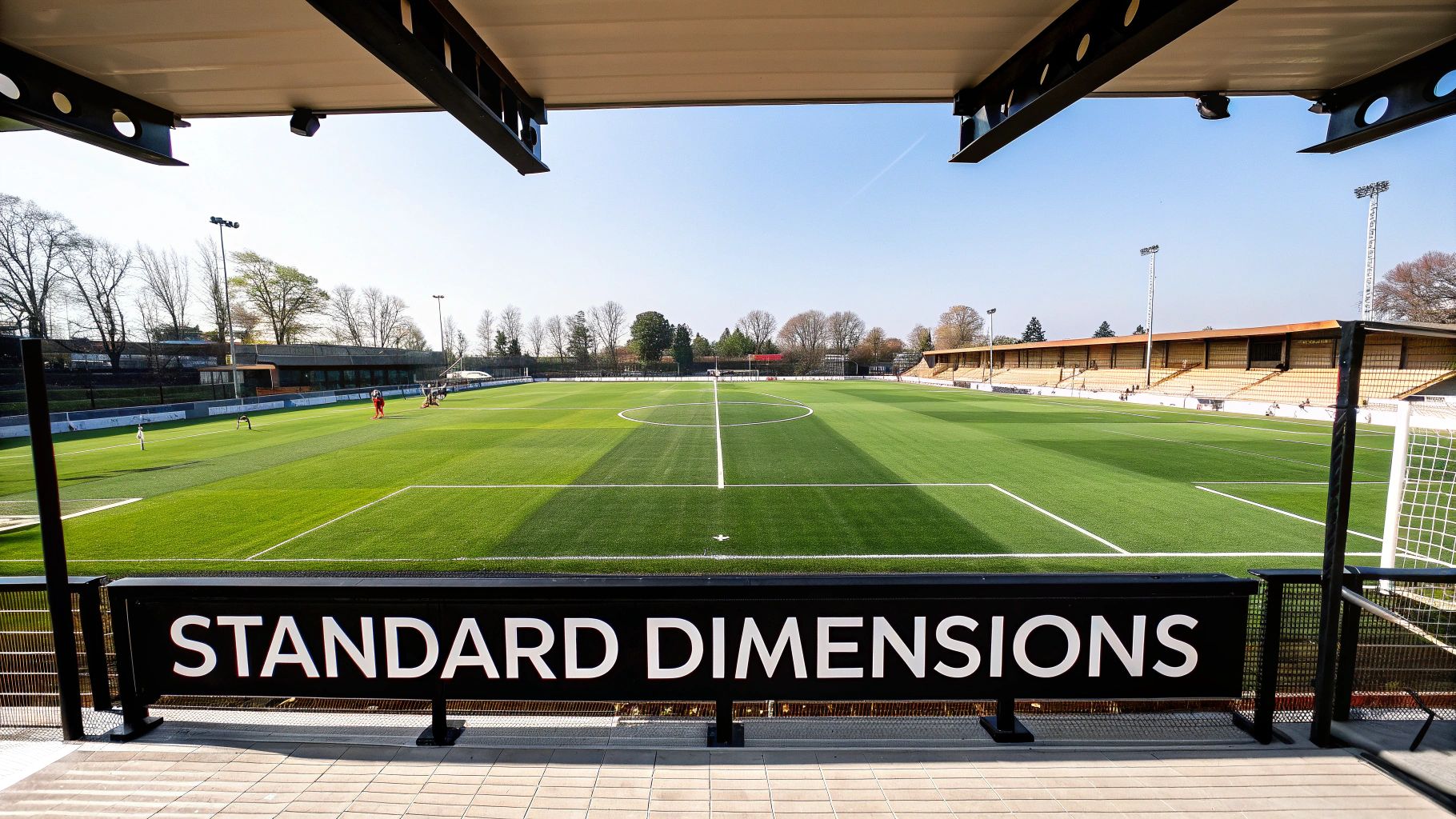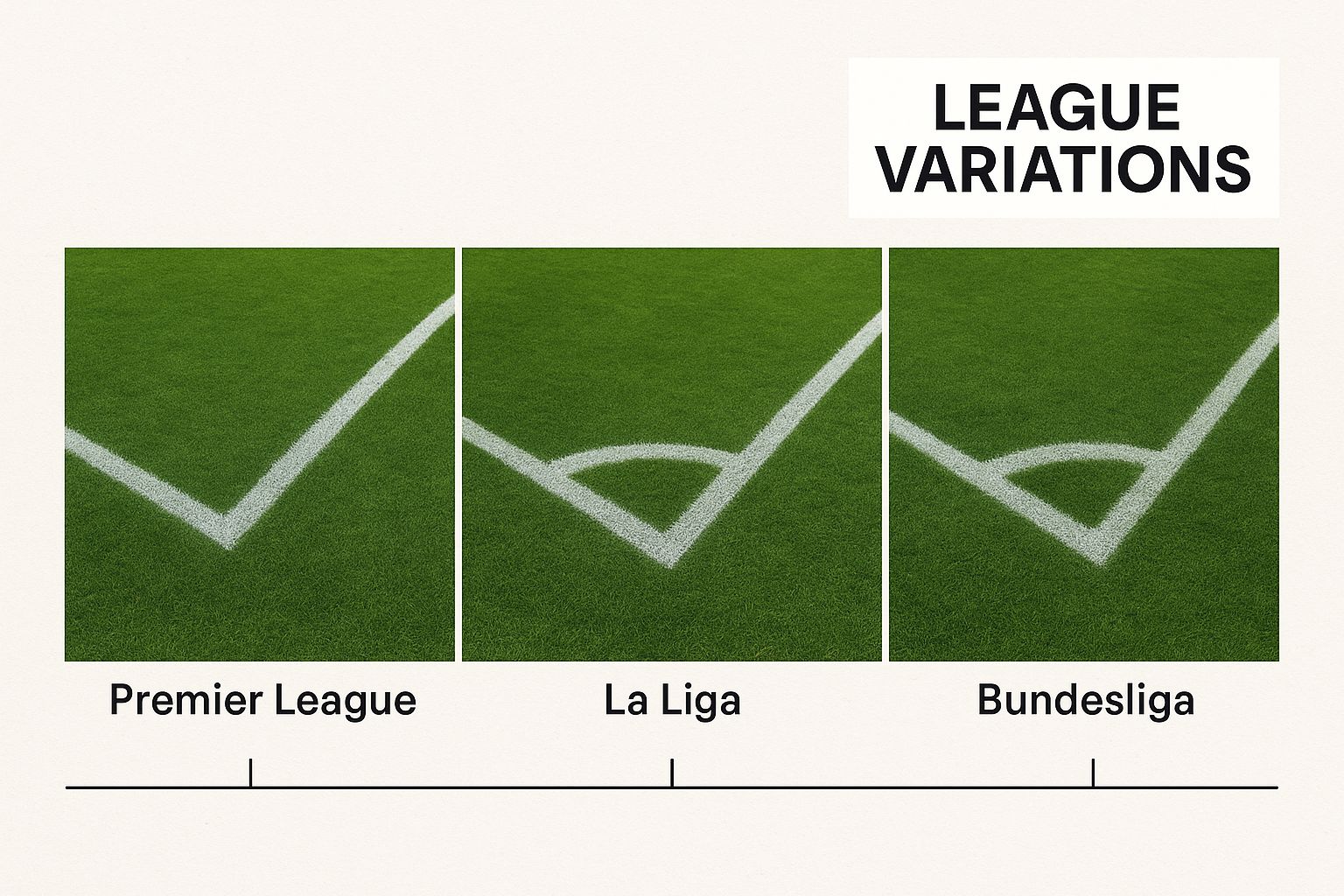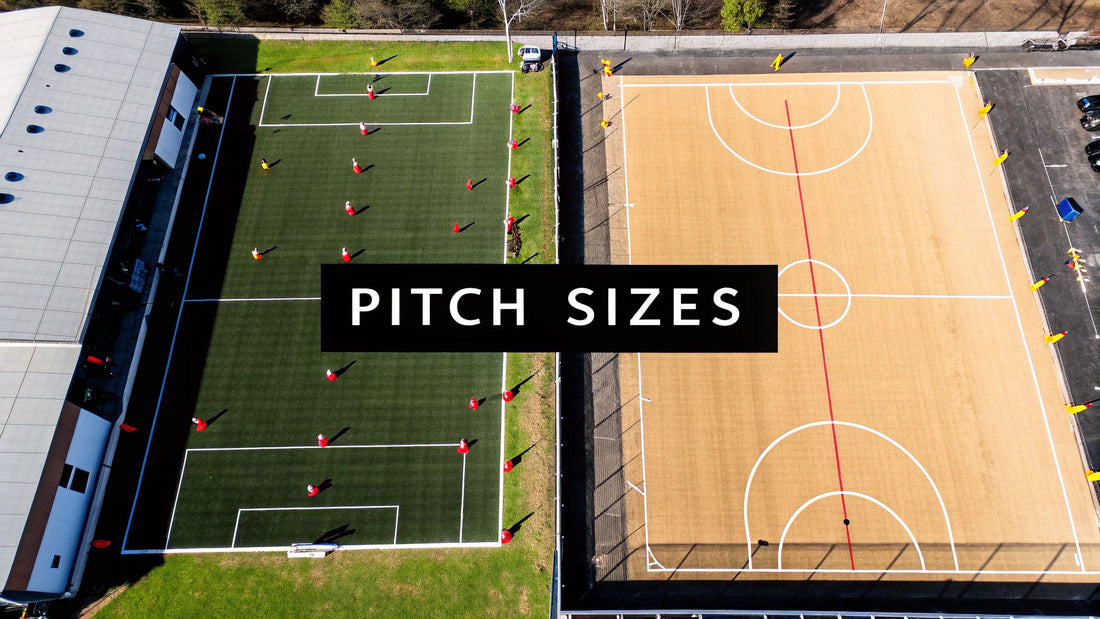Let's get one thing straight right from the kick-off: no, football pitches are not all the same size.
It’s a common misconception. You’d be forgiven for thinking every pitch is identical, like a tennis court or a basketball court, with exact, non-negotiable dimensions. But in football, the rules are more flexible. As long as a pitch fits within an approved range of lengths and widths, it's good to go.
Why Are Football Pitches Not All The Same Size?
So, if you’ve ever watched a match at one stadium and then another and thought, "hang on, that pitch looks way bigger," your eyes weren't playing tricks on you. The simple answer is no, they aren't all uniform. But the reasons why are woven into the very fabric of the game’s history and how it’s governed today.

Instead of a single, fixed measurement, the official rules lay out a minimum and a maximum for both the length and the width. This creates an acceptable "range" for a pitch to be considered regulation size. The final dimensions of any given pitch usually come down to a few key factors:
- The Level of Play: Professional, international matches have a much stricter and narrower range of acceptable sizes compared to your local Sunday league or youth games.
- The Governing Body: The rules laid out by FIFA for World Cups can be slightly different from the regulations set by a national body, like The FA in England.
- Historical Stadium Constraints: This is a big one. Many of Europe’s most famous old grounds were built long before modern standardisation. They simply don't have the physical space to expand their pitch to the maximum permitted size.
This flexibility means a team's home ground can become a genuine tactical weapon. Take Anfield, home of Liverpool, which measures 101 metres long. Compare that to Wembley Stadium, which is a more expansive 105 metres long. Those four metres might not sound like much, but they can completely change how a game is played.
A pitch’s size isn't just a trivial detail; it’s a fundamental variable that directly influences team tactics, player stamina, and the overall flow of a match.
Below, we'll dig into the specific numbers. You'll start to see just how a few metres here or there can give a team a real home-field advantage.
Let's look at the official guidelines. The following table breaks down the permitted dimensions for both senior-level and international football, showing just how much variation is allowed.
Official Football Pitch Dimension Ranges
| Level of Play | Permitted Length (metres) | Permitted Width (metres) |
|---|---|---|
| Senior Football | 90m – 120m | 45m – 90m |
| International Matches | 100m – 110m | 64m – 75m |
As you can see, the range for general senior play is massive. A pitch could technically be a wide, almost-square 90m x 90m pitch, or a long, narrow 120m x 45m one. However, for international competitions, the rules are tightened significantly to ensure a more consistent playing experience for the world's best teams.
How British Football Standardised Pitch Sizes
Think back to the very beginnings of football in Britain. The idea of a perfectly manicured, standardised pitch simply didn't exist. Games were played on whatever bit of grass was available, and the "rules" were so loose that home teams had a massive advantage on their own familiar, often bizarrely shaped grounds. This chaotic lack of uniformity was just part of the game’s charm—and its challenge.
The first real push for consistency came from the Football Association with their original laws back in 1863. But even then, the rules allowed for a huge range of sizes to accommodate the fields people had. A pitch could be anywhere from 100 to 200 yards (91 to 183 metres) long and 50 to 100 yards (46 to 91 metres) wide. Imagine that disparity today!
It meant a team used to a massive, wide field could suddenly feel completely boxed in on a short, narrow one. Everything from player stamina to tactical game plans had to be thrown out the window. It wasn't until 1897 that some crucial amendments finally narrowed the acceptable sizes for most matches and brought in even stricter dimensions for international games. This was a real turning point for fair competition.
From Chaos to Consistency
That journey from wildly different grounds to more regulated pitches was essential for football to grow into the professional sport we know and love. It ensured that skill and strategy—not just knowing the odd bounce of your home turf—would decide who came out on top.
Today, major competitions run by organisations like The Football Association and UEFA have tightened things up considerably. Pitches must now be between 100 and 105 metres long and 64 to 68 metres wide, a far cry from the historical free-for-all.
Even with today's standards, you'll still find subtle differences between leagues, often in things like the dimensions of the penalty area or the arc on the edge of it—a small nod to the legacy of size variation.

This long road from flexible local grounds to the precisely measured pitches we see today represents over a century of progress. If you're keen to dig deeper into this, you can explore the full story of how pitches have evolved on UEFA.com.
So, How Big is a Professional Football Pitch?

When you move into the professional game, the question of pitch size gets a lot more serious. While the basic rules still allow for a bit of a range, the top competitions clamp down on this to make sure every match is played on a level playing field—literally.
For any top-tier international match, FIFA gets very specific. Their regulations state that pitches must be between 100 and 110 metres long and 64 to 75 metres wide. This tighter window stops the massive size differences you might see down at the local park and creates a more consistent standard for major tournaments like the World Cup.
In England, both The FA and the Premier League take it a step further, pushing for even more consistency. Their recommended pitch size for all top-flight grounds is 105 metres by 68 metres. This standardisation is a huge help for teams. It means they can work on their tactics knowing they won’t be surprised by a ridiculously wide or narrow pitch from one week to the next.
Famous Stadiums and Their Unique Quirks
Of course, you still find slight differences, usually because of the way a stadium was built. Take Liverpool’s iconic Anfield. Its pitch measures 101m x 68m, which is just a fraction shorter than the Premier League's preferred size. It's a tiny difference, but it was enough for the ground to miss out on hosting games for Euro 2028 because it didn’t meet UEFA's strict tournament specifications.
A pitch’s dimensions are a core part of a team's tactical playbook. A few extra metres in width can completely change the game, favouring teams who love to play an expansive, attacking style over those who prefer to stay compact and defend deep.
Still, most of the big-name stadiums you see on TV stick to the 105m x 68m standard. Grounds like Wembley, Old Trafford, and the Etihad Stadium all use these dimensions. Getting the pitch size right is just as important as having the correct gear, like a perfectly weighted training football of size 5, to ensure players can switch from the training ground to a match-day stadium without missing a beat. This drive for uniformity at the highest level shows just how much the inches and metres really matter.
Why Youth and Amateur Pitches Are Smaller
Every professional footballer started somewhere, and you can bet it wasn't on a pitch the size of Wembley’s. There’s a really simple, powerful logic behind scaling down pitches for youth and amateur football—it’s all about nurturing talent, not overwhelming it. This isn't just about saving space; it's a fundamental part of how we develop players.
Think of it like learning to ride a bike. You don't start a five-year-old on a Tour de France racing machine; you give them a smaller frame and maybe some stabilisers. The FA's official guidelines for grassroots football work on the exact same principle, laying out specific pitch sizes for different age groups and formats.
A smaller field for a 5v5 or 7v7 game isn’t a watered-down version of football—it's a smarter one. The benefits are obvious from the first whistle:
- More Ball Touches: With less ground to cover, every single player is closer to the action. This means more touches, more involvement, and more fun.
- Faster Decisions: A compact space forces young players to think and react quickly, sharpening their game intelligence under real pressure.
- Reduced Physical Strain: Let's be honest, smaller pitches are just less demanding on growing bodies. This reduces fatigue and, crucially, the risk of injury.
- Skill Development: Shorter distances make passing, shooting, and dribbling far more manageable. It allows children to build genuine confidence and sound technique.
This scaled approach is absolutely vital for building a solid foundation of skills that will last a lifetime in the game.
Supporting Development at Every Level
For amateur and Sunday leagues, pitch size is often a case of "you get what you're given" by the local council. Still, the goal should always be to follow FA grassroots guidelines wherever possible.
For coaches and parents, creating the right environment is everything. This goes beyond just the pitch markings; using appropriately sized goals and laying out training cones properly makes every practice session more effective and feel like a real match.
For young players, a smaller pitch transforms the game from a test of endurance into a lesson in skill. It ensures the focus is on development, not distance, making every minute on the field a valuable learning experience.
Capturing those moments of growth can be incredibly rewarding, too. It’s far easier to analyse player positioning and movement on a smaller field, and our guide on the best soccer tracking cameras can help you get the most out of every single session.
How Pitch Size Shapes Football Tactics
A football pitch is a lot more than just grass and lines; its dimensions are a crucial battleground in the tactical chess match between two teams. The length and width aren't just numbers on a spec sheet—they actively shape strategy and can give the home side a very real advantage.
Think of it this way: a wider pitch is like giving an artist a larger canvas. It creates more space for wingers to run riot, stretching the opposition's defence thin and creating acres of room to whip in dangerous crosses. Teams that love switching the play with long, diagonal passes thrive on these expansive surfaces. It pulls defenders out of their comfortable shape and opens up gaps to exploit.
On the other hand, a narrower pitch forces teams to play through congested central areas. This can be a huge plus for sides that build their game on a high press and a compact defensive block.
With less ground to cover from side to side, defenders can hunt in packs, close down opponents much quicker, and make the pitch feel incredibly crowded for the attacking team. It’s a dream for teams that excel at quick, intricate passing in tight spaces.
Adapting to the Battlefield
Good managers have to be masters of adaptation. Their entire game plan might need a rethink based on the dimensions of the pitch they’re playing on. You only have to look at the historical differences in UK pitch sizes to see how this became a fundamental part of the sport. Early rules allowed for massive variations, so teams naturally developed playing styles perfectly suited to their home ground. To see just how much the rules have changed over the years, you can explore more details on historical pitch size regulations.
This tactical flexibility is something coaches work on relentlessly. Drills are often designed to mimic the conditions of an upcoming away match, whether that means condensing play into a smaller area or practising long-ball accuracy for a larger one. You can find some brilliant examples in our guide to effective coaching drills for soccer.
At the end of the day, understanding how to use—or nullify—the pitch's dimensions is a hallmark of a truly great team.
Common Questions About Pitch Sizes
The world of football pitch dimensions can be surprisingly complex. You'd think a rectangle is just a rectangle, but the subtle differences raise a lot of questions. To clear things up, we've tackled some of the most common queries, drawing on the key takeaways from our guide.
What's the Standard Premier League Pitch Size?
While the official rules allow for a range of sizes, most Premier League clubs have settled on a voluntary standard of 105 metres long by 68 metres wide. Think of it as a gentlemen's agreement. It's not a strict rule, but it promotes a level playing field and consistency for both teams and broadcasters.
This uniformity means that when a team travels for an away game, they know what to expect. They’re playing on a surface with familiar dimensions, removing one big variable from the tactical equation. That said, because it's only a recommendation, some older stadiums might have slight variations.
Is Wembley's Pitch Bigger Than Other Stadiums?
Yes, but only slightly. Wembley's famous turf measures 105 metres long by 69 metres wide. This makes it a touch wider than the standard 105m x 68m pitch you'll find at most Premier League grounds, placing it at the larger end of the officially permitted scale.
That extra metre of width really contributes to the feeling of space when you watch a game there, giving wingers a bit more room to breathe and operate. It’s not, however, the absolute maximum size allowed under FIFA's international regulations.
A pitch’s size isn’t just a background detail; it's a strategic element. Even a single metre of width can influence player positioning, passing lanes, and the overall tactical approach of a team, highlighting how no two pitches are truly identical.
Why Are Youth Football Pitches So Much Smaller?
Putting children on a full-sized pitch would be like asking them to play basketball with a ten-foot hoop – it just doesn't make sense for their development. Youth pitches are intentionally smaller, following The FA's recommendations, to scale the game to their physical and technical abilities.
This approach offers a few massive benefits:
- More Touches: A smaller pitch means players are always closer to the action. More involvement, more touches on the ball, and more fun.
- Real Skill Development: Shorter distances for passing and shooting allow children to actually focus on their technique, rather than just hoofing the ball as hard as they can.
- Smarter Players: The compact space forces young players to think and act faster. It's a brilliant way to sharpen their football intelligence from day one.
Ultimately, it makes the game far more enjoyable and a much better teaching tool for the next generation of players.
Does a Bigger Pitch Always Mean More Goals?
Not necessarily. It’s a common misconception. While on paper a larger pitch creates more space for attackers to run into, it's a double-edged sword. All that extra space also gives defenders more time to track back, get organised, and snuff out the danger.
Tactics play a far bigger role than size alone. A well-drilled team that defends in a compact block can be just as tough to break down on a huge pitch as on a tight one. The bottom line is there is no direct correlation between a bigger pitch and more goals.
At SoccerWares, we know the love for the game runs deep, from the grassroots pitches to the grandest stadiums. Whether you're training to master a small-sided game or cheering your heroes on from the stands, you can find all the fan apparel and high-quality training gear you need to show your support at https://soccerwares.com.

